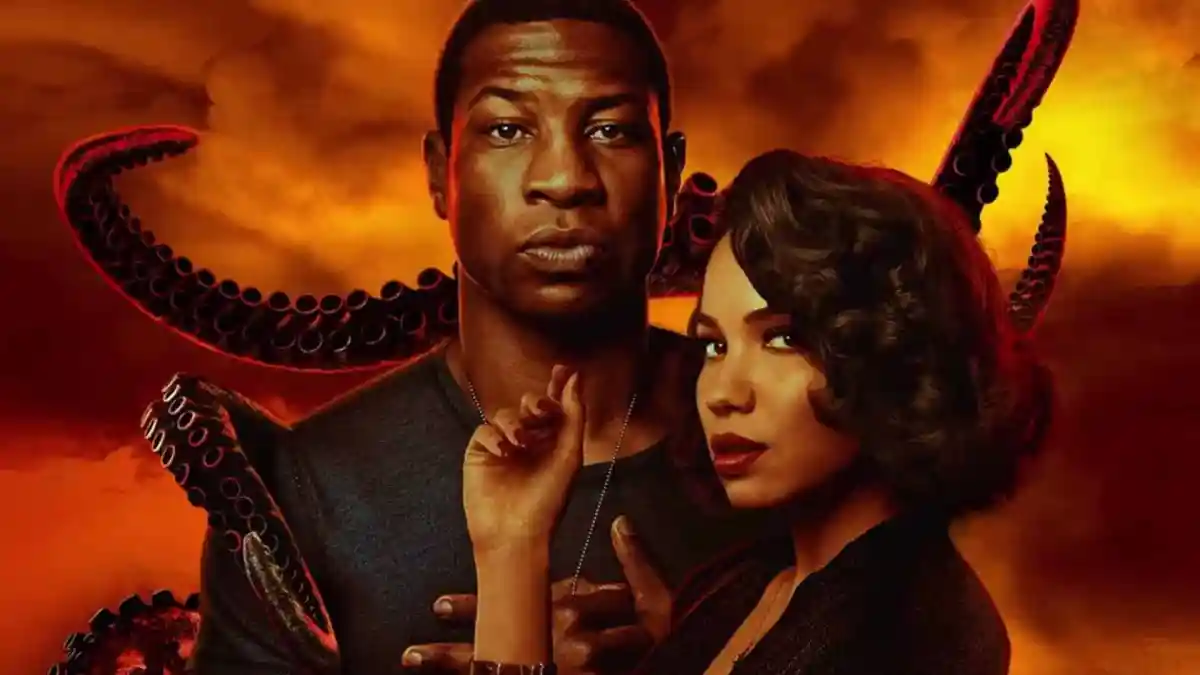Lovecraft Country is an exploration of places that exist in the American consciousness, if not on the American continent. It is a trip through the country’s shared imagination, its haunted dreamscape.
This is obvious from the opening moments. “This is the story of a boy and his dream,” introduces a narrator. The voiceover is taken from the 1950 biography, The Jackie Robinson Story, and it speaks to the general aesthetic of Lovecraft Country. Over the course of the first episode, “Sundown,” Lovecraft Country plays as a series of extended samples and remixes. The series draws from a variety of sources, name-dropping movie stars and even quoting at length from writer James Baldwin.
In that opening sequence, the audience is exposed to a smorgasbord of pop culture references. Newsreel music plays as the camera pulls through what looks like a First World War trench in black and white. Color bleeds into the frame as flying saucers hover overhead and tentacled monsters sweep through the sky. A beautiful red Martian princess (Jamie Chung) beams down, as Jackie Robinson (Robert Hamilton) himself takes a baseball bat to the swooping monsters.
This sequence is inevitably the story of a boy and his dream. Atticus “Tic” Freeman (Jonathan Majors) jolts awake on a bus, having nodded off while reading Edgar Rice Burroughs. Although appreciably less intense, Lovecraft Country retains its sense of dreamlike wonder as Tic drifts back to the real world. “Life could be a dream,” sing the Crew Cuts against lovely establishing shots of the bus traveling on country roads, idyllic green countryside stretching as far as the eye can see.
Like a lot of horror and fantasy, Lovecraft Country blurs the line between reality and dream. Tic has decided to return home following the disappearance of his father, Montrose (Michael K. Williams). Montrose left his son a letter, claiming to have gone exploring Arkham in Massachusetts. That location features heavily in the work of author H.P. Lovecraft. It also doesn’t exist. “Lovecraft based it on Salem, but that’s not real,” Montrose’s brother George (Courtney B. Vance) warns Tic.
George eventually determines that Tic misread his father’s letter. Due to Montrose’s clumsy handwriting, Tic mistook a “d” for a “k.” Montrose is really in Ardham, Massachusetts. There’s just one problem: Ardham doesn’t appear to exist either. There is simply a blank spot on a map where the town is supposed to be. Nevertheless, George and Tic embark on an adventure, taking Tic’s old high school friend Letitia “Leti” Lewis (Jurnee Smollett) with them.
Lovecraft Country draws from a rich tradition of American pulp history, most notably the work of H.P. Lovecraft. Lovecraft is a writer with a complicated legacy, most obviously because of his virulent racism. This legacy is more complicated because so much of Lovecraft’s horror is tied up in that xenophobia, that paranoid fear of “the other.” Still, Lovecraft remains one of the giants of American horror fiction, his influence felt on works as diverse as The Thing and The Evil Dead.
Early in “Sundown,” Tic ruminates on what it means to be a young black man who loves the work of writers who might charitably be described as “problematic faves.” He explains, “Stories are like people. Loving them doesn’t make them perfect. You just try and cherish ’em, overlook their flaws.” It’s a mature and considered attitude, one that reflects the reality of fans who have often had to create spaces for themselves while celebrating art that doesn’t necessarily see them.
Tic is a fan. His celebration of writers like Lovecraft and Burroughs is rooted in the same desire for escapism that would draw white readers, albeit filtered through his acknowledgement of the limited options open to him as a black man in 1954. “I love pulp stories,” he states. “I love that the heroes get to go on adventures in other worlds, defy insurmountable odds, defeat the monster, save the day. Little negro boy from the southside of Chicago don’t notoriously get to do that.”

“Sundown” is populated with spaces off limits to the characters based on their race. George is working on a guidebook listing safe stops for black travelers, another fictionalized version of the guide that inspired Green Book, 2018’s Best Picture-winning feel-good race-relations parable. Lovecraft Country is certainly less “feel-good.” Wholesome diners become dangerous spaces. The trio drive through a “sundown” county that bans African Americans after dark.
However, Lovecraft Country argues that it wasn’t only physical spaces that excluded people like Tic. The show suggests that ideological and imaginary spaces were also long out of bounds for women or people of color. Tic is able to enjoy the work of writers like Lovecraft and Burroughs, but with the understanding that he would be very unlikely to see such a story told in such a way as to welcome his perspective or to reflect his experience or even with him as an intended audience.
Of course, Lovecraft Country is set in the 1950s. Things have improved since then. However, minority perspectives are still vastly underrepresented in pop culture. The Marvel Cinematic Universe is one of the most successful cinematic franchises of the modern era, but the company still waited until its 18th film to produce a movie with a black lead and its 21st film to produce a movie with a solo female lead. Ava DuVernay only became the first woman of color to direct a $100M film in 2016.
This exclusion has consequences. So much of how people relate to the world is filtered through the lens of art, and so much of how art portrays the world is reflected back into reality. Roger Ebert called cinema “a machine that generates empathy,” so what does it mean to exclude (or limit the access of) entire identities of people from that empathy? Art — even (and maybe especially) pulp fiction — allows the audience to experience the world through the eyes of another. Why limit that?

“Sundown” quotes extensively (albeit anachronistically) from James Baldwin’s speech to the Cambridge Union in 1965 about how “the American Dream is at the expense of the American negro.” Again, there’s that sense of fighting for some room in these shared dream spaces that permeates Lovecraft Country. Baldwin decried that the United States “in its whole system of reality” had failed to evolve any conceptual place for African Americans.
Creating such a space is arguably one of the core functions of “transformative” fan fiction, as written by fans who often felt excluded from the narrative that they loved. Critic Joelle Monique has argued that Lovecraft Country is “fan fiction,” and she’s not wrong. It’s a reworking of the tropes and conventions of a popular subgenre of American fiction to include characters that would have been either completely ignored or treated with active hostility in the work themselves.
“Sundown” offers examples of this shift in perspective, suggesting what Lovecraft’s monstrous reality-destroying horrors might look like to a black person in 1950s America. Stopping in the woods, Tic explains the concept of a monstrous “shoggoth” to Leti. As he does, a police car turns around the bend and slowly pulls up to the travelers. In doing so, “Sundown” explicitly connects Lovecraft’s fear of horror lurking beneath the world’s surface to Tic and Leti’s experiences.
The three adventurers are later accosted by police officers for being caught after dark. Their nightmare experience is interrupted by an attack from a group of vampires. Vampires are so familiar a horror trope that George can casually quote Dracula to explain the logic driving them, but “Sundown” repurposes these creatures as a metaphor for the horrors waiting after dark for African American travelers in “sundown” communities. As Tic states, “We just need to survive ‘til sun-up.”
Lovecraft Country dares to carve out space for its characters in the American Dream. In doing so, it explores the lingering trauma of an American nightmare.






Published: Aug 23, 2020 11:00 am